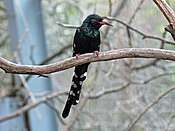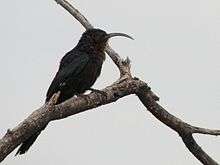Wood hoopoe
The wood hoopoes and scimitarbills are a small African family, Phoeniculidae, of near passerine birds. They live south of the Sahara Desert and are not migratory. While the family is now restricted to Sub-Saharan Africa, fossil evidence shows that it once had a larger distribution. Fossils attributed to this family have been found in Miocene rocks in Germany.[1]
| Wood hoopoes | |
|---|---|
.jpg) | |
| Green wood hoopoe | |
| Scientific classification | |
| Kingdom: | Animalia |
| Phylum: | Chordata |
| Class: | Aves |
| Order: | Bucerotiformes |
| Family: | Phoeniculidae Bonaparte, 1831 |
| Genera | |
The wood hoopoes are related to the kingfishers, the rollers, and the hoopoe, forming a clade with this last according to Hackett et al. (2008).[2] A close relationship between the hoopoe and the wood hoopoes is also supported by the shared and unique nature of their stapes.[3] The wood hoopoes most resemble the true hoopoe with their long down-curved bills and short rounded wings. According to genetic studies, the two genera, Phoeniculus and Rhinopomastus, appear to have diverged about 10 million years ago, so some systematists treat them as separate subfamilies or even separate families.[4]
Description
The wood hoopoes are a morphologically distinct group, unlikely to be mistaken for any other.[5] These species are medium-sized (23–46 centimetres or 9–18 inches long, much of which is the tail).[4] They have metallic plumage, often blue, green or purple, and lack a crest.[6] The sexes are similar in all but two species, the forest wood hoopoe and the common scimitarbill.[7] Their bills are either red or black, although young red-billed species also have black bills and bill colour is correlated with age. The legs are scarlet or black, short, with thick tarsi. They climb tree trunks in the manner of a woodpecker, and when feeding on the ground they hop rather than walking like the true hoopoe.[5] Their tails are long and strongly graduated (the central feathers are the longest), and marked conspicuously with white, as are their wings.[4][7]
Range and behaviour
These are birds of open woodland, savannah, or thornbrush, and are mainly arboreal. They require large trees both for feeding on as well as to provide hollows for nesting and nocturnal roosting. Two species are found exclusively in rainforest, the forest wood hoopoe and the white-headed wood hoopoe. All the other species are found in more open woodland and bush.[5]
They feed on arthropods, especially insects, which they find by probing with their bills in rotten wood and in crevices in bark.[7] They nest in unlined tree holes, laying two to four eggs, which are blue, grey, or olive, and unmarked in most species.[4]
Species
There are eight species.
Family: Phoeniculidae
| Image | Genus | Living Species |
|---|---|---|
 | Phoeniculus Jarocki, 1821 |
|
.jpg) | Rhinopomastus Jardine, 1828 |
|
References
- Mayr, Gerald (2000). "Tiny Hoopoe-Like Birds from the Middle Eocene of Messel (Germany)". Auk. 117 (4): 964–970. doi:10.1642/0004-8038(2000)117[0964:THLBFT]2.0.CO;2.
- Hackett, Shannon J.; Kimball, RT; Reddy, S; et al. (2008). "A Phylogenomic Study of Birds Reveals Their Evolutionary History". Science. 320 (5884): 1763–8. doi:10.1126/science.1157704. PMID 18583609.
- Feduccia, Alan (1975). "The Bony Stapes in the Upupidae and Phoeniculidae: Evidence for Common Ancestry" (PDF). The Wilson Bulletin. 87 (3): 416–417.
- Fry, C. Hilary (2003). "Wood-hoopoes". In Perrins, Christopher (ed.). The Firefly Encyclopedia of Birds. Firefly Books. pp. 383. ISBN 1-55297-777-3.
- Ligon, D (2001). "Family Phoeniculidae (Woodhoopoes)". In Josep, del Hoyo; Andrew, Elliott; Sargatal, Jordivdg (eds.). Handbook of the Birds of the World. Volume 6, Mousebirds to Hornbills. Barcelona: Lynx Edicions. pp. 412–427. ISBN 84-87334-30-X.
- Forshaw, Joseph (1991). Encyclopaedia of Animals: Birds. London: Merehurst Press. pp. 148–149. ISBN 1-85391-186-0.
- Zimmerman, Dale A.; Turner, Donald A.; Pearson, David J. (1999). Birds of Kenya and Northern Tanzania. Princeton University Press. p. 395. ISBN 0691010218.
External links
| Wikimedia Commons has media related to Phoeniculidae. |
- Wood hoopoe videos on the Internet Bird Collection
